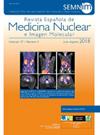使用定量参数SUL对18F-FDG PET/TC的体内发热影响
IF 1.6
4区 医学
Q3 RADIOLOGY, NUCLEAR MEDICINE & MEDICAL IMAGING
Revista Espanola De Medicina Nuclear E Imagen Molecular
Pub Date : 2025-05-15
DOI:10.1016/j.remn.2025.500127
引用次数: 0
摘要
发热会影响肿瘤在18F-FDG PET/CT上的识别和疗效评价,参照正常组织代谢可以降低这种影响。本研究的目的是利用PET/CT定量参数SUV标准化瘦体质量(SUL)分析发热对纵隔血池、肝脏、脾脏和骨髓中葡萄糖代谢的影响。材料与方法回顾性分析我科在3周内行18F-FDG PET/CT检查的30例不明原因发热患者和24例体温正常的肿瘤筛查患者。分别测定两组纵隔血池、肝脏、脾脏、骨髓的SULmax和SULmean,采用独立样本t检验或Wilcoxon-Mann-Whitney检验比较两组间的差异。结果发热组肝脏SULmax、SULmean均低于对照组(P = 0.001、0.013)。发热组脾、骨髓SULmax、SULmean均高于对照组(P < 0.05)。发热组纵隔血池SULmax低于对照组(P = 0.007),而发热组纵隔血池SULmax与对照组比较差异无统计学意义(T = 1.181, P = 0.221)。结论发热可影响脏器糖代谢。两组纵隔血池sul均值差异无统计学意义。或许血池SULmean可以作为肿瘤发热患者疗效评价的校准参数。本文章由计算机程序翻译,如有差异,请以英文原文为准。
Influencia de la fiebre en el 18F-FDG PET/TC in vivo utilizando un parámetro cuantitativo SUL
Introduction
Fever can affect the identification and efficacy evaluation of tumors on the 18F-FDG PET/CT, and this effect can be reduced by referring to normal tissue metabolism.The aim of the study was to analyze the influence of fever on glucose metabolism in the mediastinal blood pool, liver, spleen, and bone marrow utilizing PET/CT quantitative parameter SUV normalized by lean body mass(SUL).
Materials and methods
30 patients with fever of unknown origin and 24 patients for tumor screening with normal body temperature within 3 weeks, who underwent 18F-FDG PET/CT in our department, were analysed retrospectively. The SULmax and SULmean of the mediastinal blood pool, liver, spleen, and bone marrow were respectively measured in the two groups, and the differences between the two groups were compared by independent sample t test or Wilcoxon-Mann-Whitney test.
Results
The SULmax and SULmean of the liver in the fever group were lower than those in the control group (P = .001, .013). The SULmax and SULmean of spleen and bone marrow in the fever group were higher than in the control group (all P < .05). The SULmax of the mediastinal blood pool in the fever group was lower than that in the control group (P = .007), but there was no significant difference in SULmean of the mediastinal between the fever group and the control group (T = 1.181, P = .221).
Conclusion
The fever can affect the glucose metabolism in internal organs. But there was no significant difference in the SULmean of mediastinal blood pool. Perhaps the SULmean of the blood pool can be invoked as a calibration parameter in the evaluation of efficacy in tumor patients with fever.
求助全文
通过发布文献求助,成功后即可免费获取论文全文。
去求助
来源期刊

Revista Espanola De Medicina Nuclear E Imagen Molecular
RADIOLOGY, NUCLEAR MEDICINE & MEDICAL IMAGING-
CiteScore
1.10
自引率
16.70%
发文量
85
审稿时长
24 days
期刊介绍:
The Revista Española de Medicina Nuclear e Imagen Molecular (Spanish Journal of Nuclear Medicine and Molecular Imaging), was founded in 1982, and is the official journal of the Spanish Society of Nuclear Medicine and Molecular Imaging, which has more than 700 members.
The Journal, which publishes 6 regular issues per year, has the promotion of research and continuing education in all fields of Nuclear Medicine as its main aim. For this, its principal sections are Originals, Clinical Notes, Images of Interest, and Special Collaboration articles.
 求助内容:
求助内容: 应助结果提醒方式:
应助结果提醒方式:


